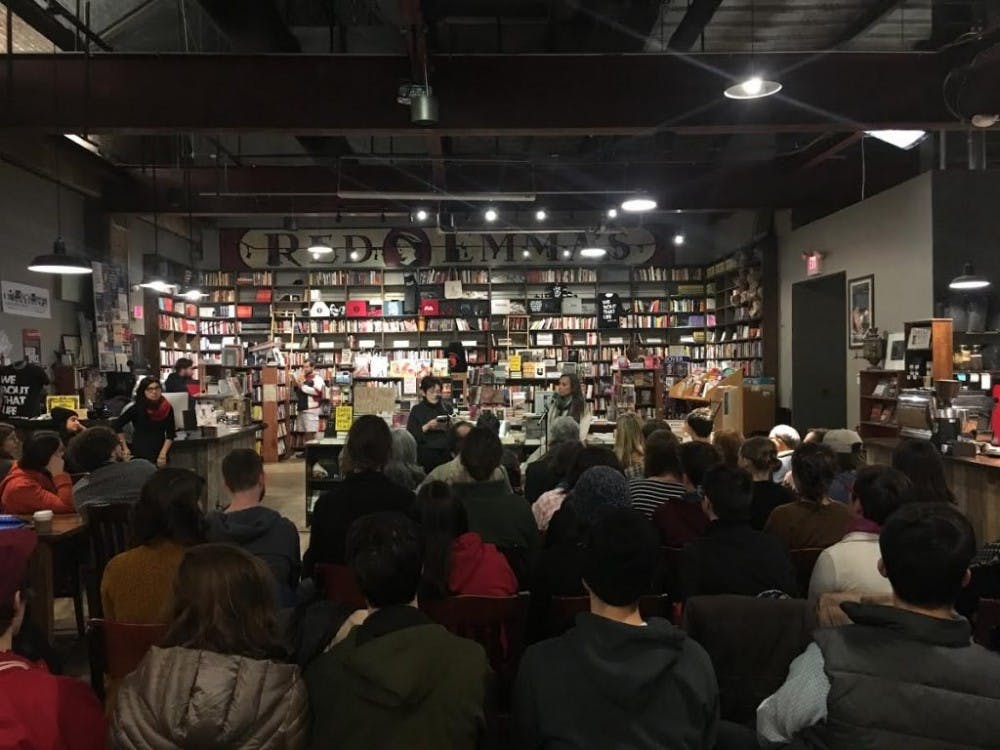Historian Roxanne Dunbar-Ortiz and journalist Dina Gilio-Whitaker spoke about their new book, “All the Real Indians Died Off” and 20 Other Myths About Native Americans, at Red Emma’s Bookstore Coffeehouse last Friday.
The co-authors discussed common misconceptions about Native American culture and history and the recent protests against the Dakota Access Pipeline (DAPL) near the Standing Rock Sioux Reservation in North Dakota.
The event took place two days before the U.S. Army Corps of Engineers announced it would reroute the pipeline, a decision considered a victory for those who oppose the DAPL.
Over the past few months, thousands of protesters have traveled to North Dakota to demonstrate against the project. The protesters have been concerned that the DAPL may pollute the Sioux tribe’s drinking water and endanger sacred burial sites.
Dunbar-Ortiz began the talk by sharing one chapter titled, “Indians Were Savage and Warlike.” It was selected for the event because of its connection to the Native American tribes protesting the pipeline. She traced the history of the word “savage” from America’s founding to its use in society today.
“In the context [of Standing Rock], the authorities [have tried] to portray the water protectors as being violent and savage to tap into that fear of the savage that is in the DNA of the public,” Dunbar-Ortiz said.
Dunbar-Ortiz then chronicled various military conflicts involving Native Americans, including the Battle of Wounded Knee and the French and Indian War. She spoke about how Europeans fought to expand their territory, economy and religion, while Native Americans fought to maintain social and economic stability.
Throughout the chapter, the authors addressed widely held misconceptions.
“The narrative of Indian savagery is a lie told so many times that it became truth in the American mind,” she said. “It was one of the necessary truths used to justify European, and later, American violence against indigenous peoples, to fulfill the demands of imperialism.”
Gilio-Whitaker elaborated on the priority access she received as a Native American journalist covering the Standing Rock protests. She was there during Thanksgiving week and was on assignment for Indian Country Today. She estimated that there were between 8,000 and 13,000 people protesting DAPL’s construction.
“It was disorienting. To be a native person in the settler’s state is to always be invisible; it’s to always have to defer to white norms, white values, white control,” Gilio-Whitaker said. “To be in the camp as a native person is the opposite. It’s to be with your own people in your own space.”
During the question and answer period, audience members posed questions on topics like Native American history in public schools and the role of U.S. Army Corps of Engineers in the DAPL project.
One man commented on the contrast between Native American and European cultures.
“With Standing Rock, Western culture doesn’t really care,” he said. “We’ve come to think that we can live without nature.”
Dunbar-Ortiz jumped in to clarify some of the audience member’s claims. She distinguished the differences between European and colonial culture.
“I want to say something: It’s not the culture of Europe, it’s the culture of conquest [that is the problem],” she said. “They transformed into the culture of conquest and the United States has taken up that DNA. I think you have to be really careful saying that something is inherent.”
Another audience member inquired about the connection between capitalism and blood quantum or the percentage of Native American blood in an individual’s ancestry.
Gilio-Whitaker drew comparisons between the capitalist aims behind both blood quantum laws and the one-drop rule, which was used to classify a person with any percentage of black ancestry as black.
“The one-drop rule is about maintaining slavery,” she said. “At its core, it’s about policing racial boundaries because with rape of slave women and the birth of those children, there’s a constant replenishing of the slave population.”
Gilio-Whitaker then went on to talk about how it perpetuates divisions between black people and white people.

“It works later to maintain segregation. That was obviously a capitalist project,” she said. “With native people, it was about getting the land, so you force assimilation in order to gain access to the land.”
Audience members responded positively about the discussion.
Kim Richardson, a self-described urban Indian and member of the Haliwa-Saponi tribe in North Carolina, was selling T-shirts with phrases such as “We are Water” and “Support Indigenous Peoples Day.” She was at the event to show support for the people of Standing Rock.
“Our tribe is facing similar issues with the Atlantic Coast Pipeline, which is a natural gas pipeline coming through our community,” she said.
Richardson appreciated that blood quantum was discussed in depth.
“I am of mixed ancestry,” she said. “I am constantly asked what my ethnicity is. Native Americans seem to be the only ethnic group that needs to have a tribal card to show your blood quantum. That kind of hit home with me.”
Journalist Jordannah Elizabeth was interested in exploring the Native American experience and thought that Gilio-Whitaker and Dunbar-Ortiz’s book was a good way to start expanding her knowledge. She enjoyed hearing the authors’ remarks, particularly Gilio-Whitaker’s experience as a journalist.
“I [wrote down] a quote from Gilio-Whitaker when she talked about being a native journalist,” she said. “As an African-American journalist working in a settler’s world and being a music journalist in a white, male-dominated community... that resonated with me.”
She also was pleased to see many Baltimoreans at the event.
“I feel very honored that Baltimore came out and that the attendance for this event was overwhelming,” she said. “I was born and raised here so that makes me proud as a Baltimore native to see that we all are dying to be enlightened and are dying to support Standing Rock and the Native American nation in general.”
MICA senior Ashley Wu decided to attend the event because of her interest in social justice and her desire to learn more about Native American communities.
“Instead of just wanting to state solidarity on social media, I actually wanted to understand the community and do more than just say something,” she said.





